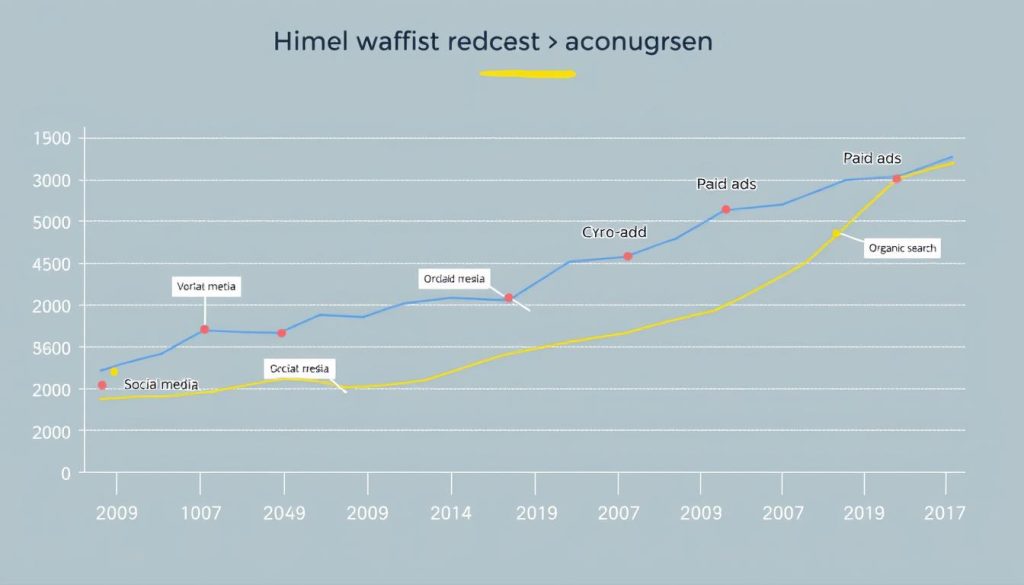Reaching your target audience is crucial in today’s competitive software landscape. Focusing on niche audiences can be a powerful strategy. By understanding your niche market, you can create tailored marketing approaches that resonate.
This guide explores key steps to promote software to niche audiences. You’ll discover insights and tactics to connect with your most relevant customers. We’ll cover understanding your market, targeted advertising, and content marketing strategies.
Key Takeaways
- Identify and deeply understand your niche audience to inform your marketing strategies
- Craft a compelling value proposition that speaks directly to your target customers’ needs
- Leverage targeted advertising channels, such as social media and search engine marketing, to reach your niche
- Utilize influencer marketing to tap into the trust and influence of industry experts and thought leaders
- Develop a content marketing strategy that provides valuable, relevant information to your niche audience
- Continuously monitor and optimize your promotional efforts to maximize their effectiveness
- Build brand loyalty and advocacy within your niche to drive long-term growth
Understanding Your Niche Audience
Promoting software to niche audiences starts with understanding your target customers. Research their interests, pain points, behaviors, and key demographics. These insights help tailor your marketing efforts to address their specific needs.
Researching Audience Interests
Identifying your niche audience’s interests is vital for creating engaging content and campaigns. Use social media analytics, customer surveys, and industry forums to uncover important topics. This helps craft messaging that aligns with their preferences and needs.
Identifying Key Demographics
Analyzing key demographics like age, location, and job title guides your marketing strategy. Study customer data, industry reports, and competitor research to build a comprehensive profile. This information shapes your messaging and channel selection for maximum impact.
“Deeply understanding your target customers is the foundation for creating effective marketing campaigns that resonate with your niche audience.”
Researching your audience’s interests and demographics equips you to develop tailored strategies. This knowledge helps attract, engage, and convert niche customers. It’s crucial for crafting a compelling value proposition.
Use this foundational knowledge to deploy targeted advertising and marketing initiatives. Your efforts will be more effective when based on a deep understanding of your audience.
Crafting a Compelling Value Proposition
A strong value proposition is crucial for your software’s success. It communicates specific benefits and solves unique problems for your target customers. Your value proposition helps you stand out in a crowded market.
Develop a unique proposition that resonates with your niche audience. This will convince them to choose your software over competitors. Focus on highlighting the advantages that matter most to your customers.
- Identify the Core Benefits: Clearly articulate the primary benefits your software provides to your niche audience. This could include improved productivity, cost savings, enhanced user experience, or any other tangible advantages.
- Highlight Unique Differentiators: Emphasize what sets your software apart from competitors. This could be unique features, a specialized focus on your niche, or a superior level of customer service.
- Address Pain Points: Demonstrate how your software directly addresses the specific pain points and challenges experienced by your niche audience. This shows that you understand their needs and can provide a tailored solution.
- Use Compelling Language: Craft a value proposition that is concise, impactful, and written in the language of your niche audience. Avoid jargon and instead focus on communicating the value in a clear and relatable manner.
| Value Proposition Element | Example |
|---|---|
| Core Benefits | Our project management software helps small businesses increase productivity by 20% through streamlined task allocation and real-time collaboration. |
| Unique Differentiators | As the only project management platform designed specifically for the legal industry, our software offers specialized features to address the unique needs of law firms. |
| Addressing Pain Points | Tired of juggling multiple spreadsheets and email threads to keep your creative team organized? Our all-in-one content calendar and collaboration tool eliminates the headache of managing projects. |
A compelling value proposition helps you communicate your software’s unique benefits effectively. It shows your understanding of your niche audience’s needs. This approach will make your product more appealing to potential customers.

Leveraging Targeted Advertising
Targeted advertising is key to promoting your software to niche audiences. Social media ads and search engine marketing help connect with relevant customers. Let’s explore these powerful strategies.
Social Media Advertising
Social media platforms offer precise audience targeting options. You can reach users based on interests, demographics, and behaviors. Craft eye-catching ads and optimize campaigns to engage your target market.
- Leverage audience targeting to reach users with specific interests and characteristics
- Create visually appealing and attention-grabbing ad creatives
- Continuously monitor and optimize your social media ad campaigns
Search Engine Marketing
Search engine marketing (SEM) complements social media efforts. It helps connect with your niche audience through keyword-targeted ads. This ensures your software is visible to users searching for similar solutions.
- Conduct thorough keyword research to identify the most relevant search terms for your niche audience
- Craft compelling ad copy that highlights your software’s unique value proposition
- Continuously optimize your SEM campaigns through A/B testing and performance analysis
Combining social media ads and SEM boosts your software promotion strategy. This approach helps you reach and engage your niche audience effectively. It ensures your efforts target your most relevant customers precisely.
Utilizing Influencer Marketing
Partnering with influential figures can boost your software’s promotion. These industry experts can help spread awareness and drive conversions. Their influence can effectively reach your target audience.
Identifying Relevant Influencers
Find the right influencers who have your audience’s trust and attention. This is key to successful influencer marketing.
Research your target audience and their favorite social media platforms. Look for industry leaders and content creators with strong engagement.
Evaluate the influencer’s audience size and alignment with your brand. Reach out to propose mutually beneficial collaborations.
- Conduct thorough research to understand your target audience and their preferred social media platforms.
- Analyze the industry leaders, thought leaders, and content creators who have a strong presence and engagement within your niche.
- Evaluate the influencer’s audience size, engagement rate, and alignment with your brand’s values and messaging.
- Reach out to the influencers you’ve identified and propose mutually beneficial collaboration opportunities.
Careful selection of influencers can boost your software’s visibility. It helps you tap into a highly engaged audience.
“Influencer marketing is one of the most effective ways to reach your target audience and drive meaningful results for your software business.”

The key is finding partners who can authentically promote your software. Research and identify influential figures in your niche.
This approach will help you harness influencer marketing’s power. It can significantly grow your software business.
Content Marketing Strategies
Content marketing is a powerful tool for software promotion. It helps reach niche audiences effectively. This approach focuses on creating valuable content for target customers.
Educational resources, industry insights, and product demos are key elements. They provide real value to your audience.
Creating Valuable Content
To become a thought leader, create content that speaks to your audience. Craft material that solves their problems and addresses their challenges.
Share deep industry analysis and trends. This establishes your brand as a trusted authority.
Develop tutorials, guides, and webinars to help customers use your software. Showcase your product’s features through engaging demos and case studies.
- Identify your audience’s pain points and challenges, then create content that addresses them directly.
- Offer in-depth industry analysis, trends, and best practices to establish your brand as a trusted authority.
- Develop educational resources, such as tutorials, guides, and webinars, to help your customers get the most out of your software.
- Showcase your software’s features and capabilities through engaging product demonstrations and case studies.
- Collaborate with industry influencers or experts to co-create content that leverages their expertise and credibility.
Position your software as a solution and thought leader in your niche. This approach attracts and engages qualified leads through compelling content marketing.
“Content marketing is a strategic marketing approach focused on creating and distributing valuable, relevant, and consistent content to attract and retain a clearly defined audience — and, ultimately, to drive profitable customer action.”
– Content Marketing Institute
Fostering Community Engagement
A thriving community can boost your software’s promotion to niche audiences. It gathers feedback, provides support, and sparks relevant discussions. Your engaged users become a powerful marketing asset.
Here are strategies to foster community engagement:
- Establish a dedicated online forum or discussion platform. This gives your users a space to share ideas, ask questions, and interact with one another.
- Encourage user-generated content. Invite your community to contribute blog posts, tutorials, or other valuable content that can be shared with the group.
- Host regular Q&A sessions or “ask me anything” events. These interactive sessions allow you to connect directly with your users and address their concerns.
- Recognize and reward active community members. Offer exclusive perks, such as early access to product updates or special recognition, to incentivize participation.
- Respond promptly to user inquiries and feedback. Demonstrate your commitment to the community by providing timely and personalized support.
These strategies help build a strong, engaged community. It promotes your software and guides product development. Your community becomes a valuable resource for marketing insights.
“A thriving community is the foundation for successful software marketing in a niche market.”
Listen to your users consistently. Address their needs promptly. Create opportunities for meaningful interaction and exchange. This approach builds brand loyalty and drives growth within your niche audience.

How To Promote Software To Niche Audiences
Promoting software to niche audiences can unlock significant growth opportunities for software companies. This approach focuses on reaching and engaging specific target customers. Let’s explore key tactics for effective niche software promotion.
Start by understanding your audience’s unique needs, preferences, and pain points. Conduct thorough market research to identify your niche’s defining characteristics. This knowledge will help develop a compelling value proposition for your target customers.
Use targeted advertising channels like social media and search engines to reach your niche audience. Create ads that showcase your software’s unique benefits. Align these ads with your target market’s specific interests and challenges.
Influencer marketing can be a powerful strategy for niche software promotion. Find relevant industry experts or thought leaders within your niche. Collaborate with them to boost your brand’s message and credibility.
Content marketing establishes your software as a trusted solution within your niche. Create valuable content that addresses your target audience’s specific needs. This positions your brand as a thought leader and go-to resource.
Fostering community engagement builds long-term relationships with your niche audience. Encourage participation and facilitate discussions. Listen to your customers to understand their evolving needs and improve your software offerings.
These strategies help software companies promote products to niche audiences effectively. They drive targeted customer acquisition and build a loyal, engaged user base.
| Strategy | Key Tactics |
|---|---|
| Understanding Niche Audience |
|
| Leveraging Targeted Advertising |
|
| Utilizing Influencer Marketing |
|
| Implementing Content Marketing |
|
| Fostering Community Engagement |
|
“The key to promoting software to niche audiences is to deeply understand their unique needs and preferences, and then deliver tailored solutions that address their pain points with laser-like precision.”
Tracking and Analyzing Results
Tracking and analyzing campaign performance is vital for software promotion success. Monitor key performance indicators (KPIs) that match your niche marketing goals. These include website traffic, lead generation, conversions, and customer engagement.
Regular analysis of these metrics helps optimize your strategies. This data-driven approach can improve your software’s reach and impact in your niche market.
Key Performance Indicators
Choosing the right KPIs is crucial for measuring your promotion strategies’ effectiveness. Here are some key metrics to consider:
- Website Traffic: Track the number of visitors to your website, the source of the traffic, and the engagement levels (e.g., time spent on site, pages viewed).
- Lead Generation: Monitor the number of leads generated through your marketing efforts, including form submissions, email signups, and other lead capture mechanisms.
- Conversions: Analyze the conversion rates for key actions, such as software downloads, free trials, or paid subscriptions, to gauge the effectiveness of your sales funnel.
- Customer Engagement: Measure the level of engagement with your software, such as user activity, feature utilization, and customer feedback, to identify areas for improvement.
| KPI | Description | Importance |
|---|---|---|
| Website Traffic | The number of visitors to your website, the source of the traffic, and the engagement levels (e.g., time spent on site, pages viewed). | Helps you understand the reach and interest in your software, as well as the effectiveness of your marketing channels. |
| Lead Generation | The number of leads generated through your marketing efforts, including form submissions, email signups, and other lead capture mechanisms. | Indicates the success of your lead generation strategies and the potential for converting those leads into customers. |
| Conversions | The conversion rates for key actions, such as software downloads, free trials, or paid subscriptions, to gauge the effectiveness of your sales funnel. | Provides insights into the effectiveness of your marketing and sales efforts, helping you optimize the customer journey. |
| Customer Engagement | The level of engagement with your software, such as user activity, feature utilization, and customer feedback, to identify areas for improvement. | Helps you understand how users interact with your software, enabling you to enhance the product and address pain points. |
Consistently tracking these KPIs allows for informed decision-making. You can fine-tune your software promotion strategies and improve user experience. This approach drives long-term success in your niche market.

Continuous Optimization
Promoting software to niche audiences requires ongoing refinement. As markets evolve and needs change, it’s vital to review strategies regularly. This ensures your promotion stays effective and impactful.
Staying agile helps maintain a competitive edge. Adapting to your audience’s changing behaviors keeps your software top-of-mind. Let’s explore how to analyze data and adjust promotional strategies effectively.
Regularly Reviewing Performance Metrics
Tracking key performance indicators (KPIs) is crucial. Monitor website traffic, lead generation, and customer engagement. Analyze this data to understand your audience’s interests and behaviors.
Use these insights to refine your strategies. Look for areas that need improvement and adjust accordingly.
Incorporating Customer Feedback
Actively seek and use customer feedback to optimize your strategies. Engage through surveys, social media, and support channels. Understand your audience’s experiences and preferences.
Use this feedback to improve your marketing content. Adjust your value proposition to align with customer needs.
Adapting to Market Changes
The software industry evolves constantly. New technologies and competitors emerge regularly. Stay informed about developments in your niche through research and industry events.
Use this knowledge to update your messaging. Ensure your software remains competitive and relevant to your target audience.
| Key Considerations for Continuous Optimization | Potential Strategies |
|---|---|
| Regular Performance Tracking |
|
| Customer Feedback Integration |
|
| Adaptability to Market Shifts |
|
Continuous optimization keeps your promotion agile and responsive. It aligns with your niche audience’s evolving needs and preferences. This approach maintains a strong market presence and drives ongoing engagement.
Foster lasting brand loyalty among your target customers. Stay adaptable and keep refining your strategies for long-term success.
Building Brand Loyalty
Promoting software to niche audiences aims to build long-term brand loyalty. We’ll explore strategies for fostering strong brand perception within your niche. These include exceptional customer service, community building, and consistent value delivery.
Exceptional customer service is crucial for brand loyalty. Ensure your team responds quickly and empathetically to customer issues. Offer various support channels like email, phone, and online chat. Strive to exceed customer expectations at every interaction.
Building a sense of community can boost brand loyalty. Create forums and social media platforms for customers to connect. Encourage user engagement through these interactive spaces. This fosters collaboration and deepens emotional connections with your brand.
Consistently delivering value is key to maintaining loyalty. Regularly update your software with useful features. Provide educational resources and exclusive content for your niche audience. This positions your software as an essential tool in their workflow.




